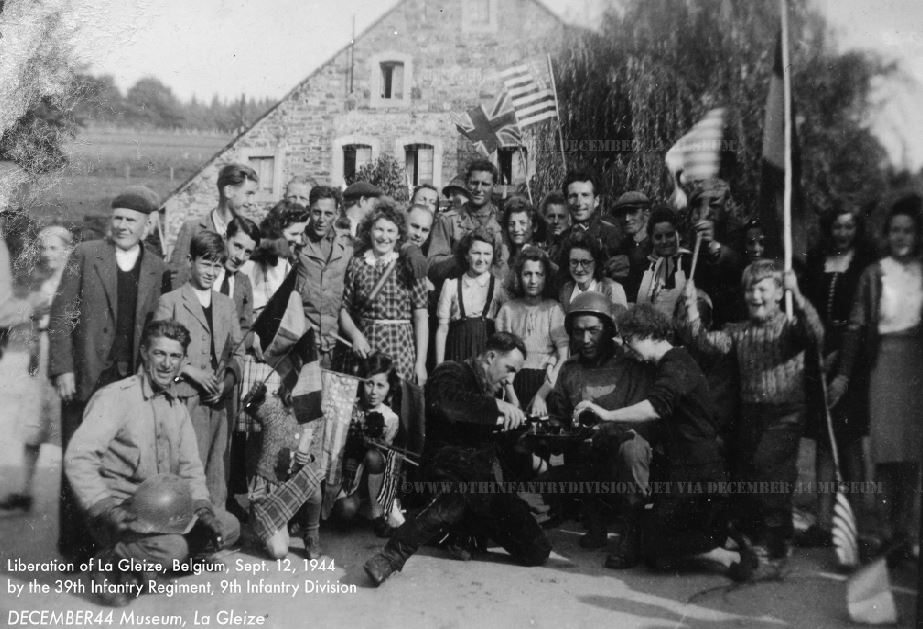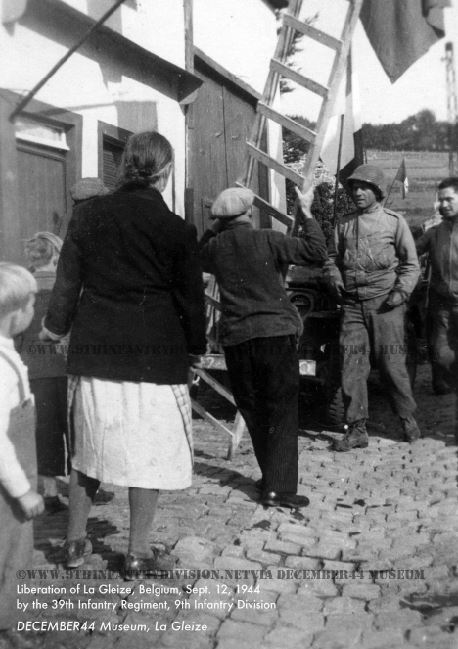The Liberation of La Gleize
39th Infantry Regiment, 9th Infantry Division
September 12th, 1944
Recently I was given these pictures by Michel de Trez, director of the December 44 Museum at La Gleize. The pictures are most interesting and shows men of the 39th Infantry Regiment in La Gleize on September 12th, 1944. What happened in those early September 1944 days in Belgium is often overlooked. I am still researching the events as I am writing this article, and will update it with new information. However, I think these pictures are amazing, and did not want to keep them from the public.
The events in Belgium, early September 1944.
After successfully crossing the Meuse River and clearing Dinant, the men of the 9th Infantry Division advanced through Belgium. VII Corps now completed the occupation of Liege and prepared to continue its advance to the east. Resistance north of the Meuse River between Namur and Liege ceased except for a few remaining stragglers.
On September 8th, 1944, the 9th Infantry Division advanced about 35 kilometers to the northeast against scattered enemy resistance. The 60th Infantry Regiment attacked in the morning and brushed aside opposition at Verlee and Borsu, and managed to be in the area southeast of Ouffet by early evening. Meanwhile, the 39th Infantry Regiment advanced to the left of the 47th Infantry Regiment and encountered intermittent resistance during the day. At the end of the short firefights, the men were located southwest of Villers le Temple, while the men of the 47th Infantry Regiment shuttled by truck to an assembly area south of Liege.
The following day, September 9th, 1944, the Division found itself east to the vicinity of the town of Verviers. The 60th Infantry Regiment pushed onward on the right and moved in a motorized column from Ouffet to Poulseur, where it crossed the Ourthe River. The Regiment continued advancing to the town of Sprimont, reduced a German strong point there, and then turned south for about three kilometers to secure the bridges over the Amblève River at Aywaille. At the end of the day, the 60th Infantry Regiment bivouaced in the Aywaille area, where they were greeted by many happy locals.
Meanwhile, the 39th Infantry Regiment moved out from Villers le Temple in trucks and advanced to the vicinity of Gomzé-Andoumont where it attacked against tank, infantry and mortar fire. Joined by a Task Force of the 3rd Armored Division, the regiment quickly eliminated the opposition, but because the armor had priority on the road, the advance was delayed and defensive positions were taken up for the night in the Louveigné area, just southwest of Gomzé-Andoumont.
The 47th Infantry Regiment was now attached to the 3rd Armored Division and manned defensive points in Liege.
Now the date was September 10th, 1944. VII Corps consolidated positions in the Verviers area as it continued its eastward advance in preparation for a drive into Germany. The Germans continued a stubborn delaying action throughout the period.
After experiencing a great welcome by the locals of Aywaille, the men of the 60th Infantry Regiment prepared for another attack. The men moved out and attacked south from Aywaille to destroy German troops retreating northeast and east of the Ourthe River. They operated right in front of the left flank of the 4th Cavalry Group. Because of lack of fuel, the infantry jumped off without the support of any armored vehicles. Overcoming a series of roadblocks the regiment established contact with the 4th Cavalry Group and by the end of the day the regiment was out posting a line from Awan southeast to Werbomont.
The 39th Infantry Regiment remained in place near Louveigné, sending its 1st Battalion to the Hoigne River at Theux to assist elements of the 3rd Armored Division. The Battalion crossed over the river and occupied the high ground north of Oneux, about two kilometers northeast of Theux. The 47th Infantry Regiment assembled near Beaufays, 9 kilometers southeast of Liege.
While all of this was happening, the 4th Cavalry Group advanced toward Stavelot, maintaining contact with the 4th Infantry Division on their right and the 9th Infantry Division on their left.
Continuing the advance northeast on the 11th, VII Corps occupied the town of Eupen near the German border and concentrated troops near the frontier in preparation for an attack across the German border. After a calm morning for the 9th Infantry Division, 2nd and 3rd Battalions of the 39th Infantry Regiment began moving across the river at Theux just west of La Hoigne, right after noon time. From here it advanced northeast, just south of Verviers, and at the end of the day deployed along a line extending from Sohan, 1,5 kilometers southeast of Pepinster, then southeast to Neufmarteau.
The 47th Regiment moved from Beaufays to an assembly area north east of Verviers, and the 60th Regiment was assembled in positions northeast of Sprimont.
The 4th Cavalry group secured Malmedy and had reconnaissance elements along the general line running from Liege through Malmedy southwest to Vielsalm.
September 11th turned into September 12th 1944, and in order to penetrate into Germany VII Corps had aligned its units abreast, with the 4th Cavalry Group on the most southern flank, the 9th Infantry Division in the right center, the 3rd Armored Division in the left center, and the 1st Infantry Division on the most northern, left flank.
On the 12th of September, 1944, men of the 4th Cavalry on the right of the 9th Infantry Division had met opposition of varying strength as it approached Malmedy. With the objective to assist the 4th Cavalry, the 39th Regimental Combat Team was ordered to clear the area south of Stoumont and La Gleize. At 0711 hours, the 39th Regimental Combat Team (less 1st Battalion) moved out on its mission to the south, with the 3rd Battalion on the right and the 2nd Battalion on the left. During this advance, no contact was made with the enemy. La Gleize was taken without too much opposition, and the men of the 39th Regimental Combat Team arrived in the village as the first Liberators, soon followed by a group of tanks. Freedom!

39th Infantry Regiment enters La Gleize, Belgium on September 12th, 1944. Note the jeep of the I & R Platoon.
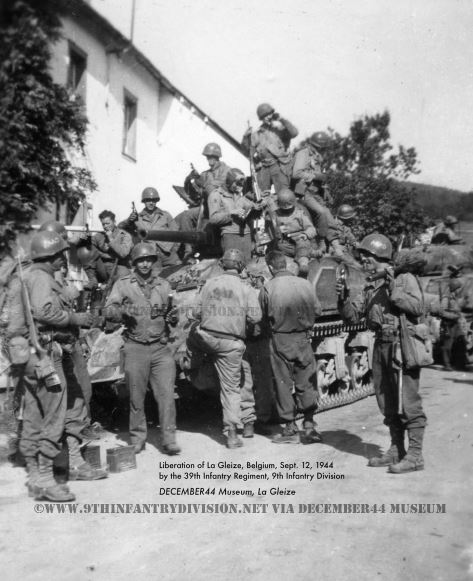
Happy GIs of the 39th Infantry Regiment after arriving in La Gleize, Belgium on September 12th, 1944.
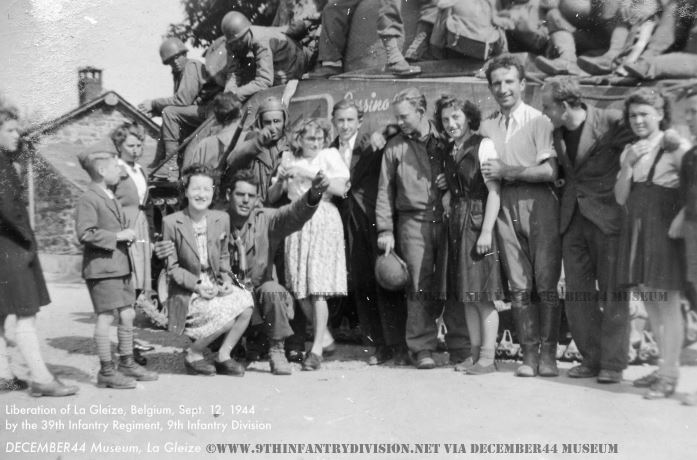
Happy locals pose with men of the 39th Infantry Regiment at La Gleize, Belgium on September 12th, 1944
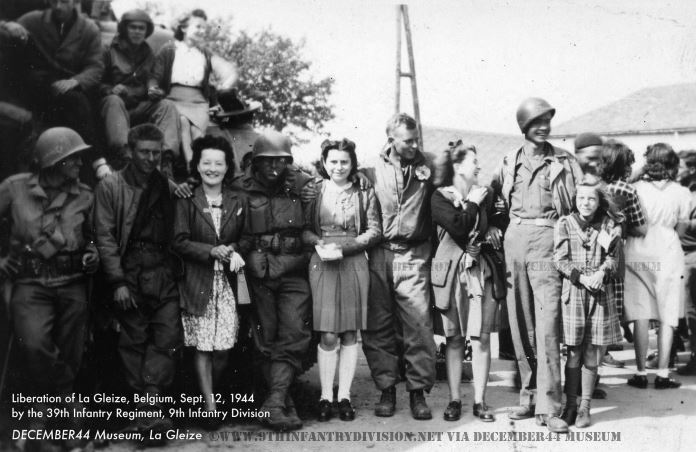
Happy locals pose with GIs of the 39th Infantry Regiment in La Gleize, Belgium, September 12th, 1944.
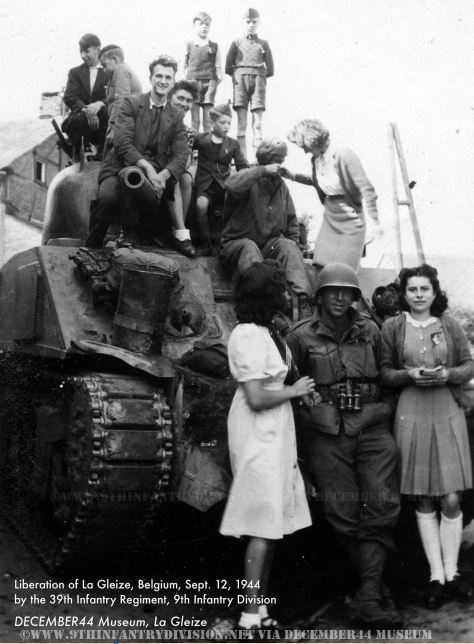
Happy locals pose with GIs of the 39th Infantry Regiment in La Gleize, Belgium, September 12th, 1944.
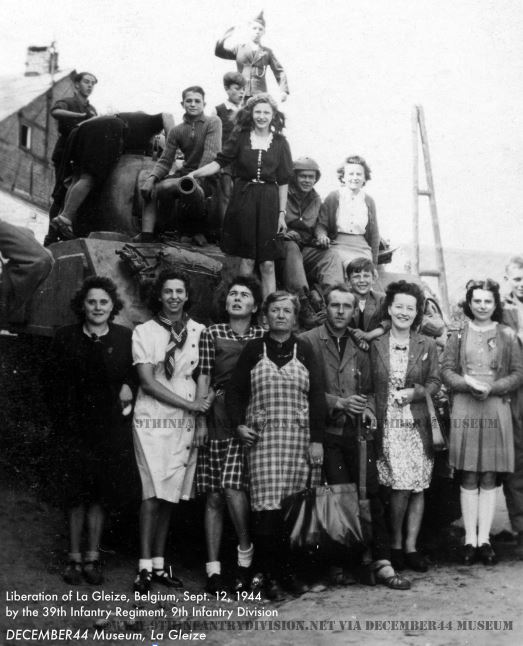
Happy locals pose with GIs of the 39th Infantry Regiment in La Gleize, Belgium, September 12th, 1944.
After the Intelligence & Reconnaissance Platoon (I&R) contacted the 4th Cavalry Group in Malmedy, the Combat Team was ordered to return to its original area east of Theux. All units were closed in their area by 1850. Upon receipt of alert orders for the next day’s operation, a reconnaissance party was sent out to investigate the road leading southeast from Verviers.
The 4th Cavalry Group advanced est against sporadic small arms and artillery fire to the general line extending from Weywertz in the south, through Waimes and Born to St. Vith.
The next day, September 13th 1944, the 9th Infantry Division was crossed the border into Germany at Roetgen. A new battle was about to begin.
Special thank you to Michel de Trez and the December 44 Museum at La Gleize for providing the pictures and allowing me to use them.
